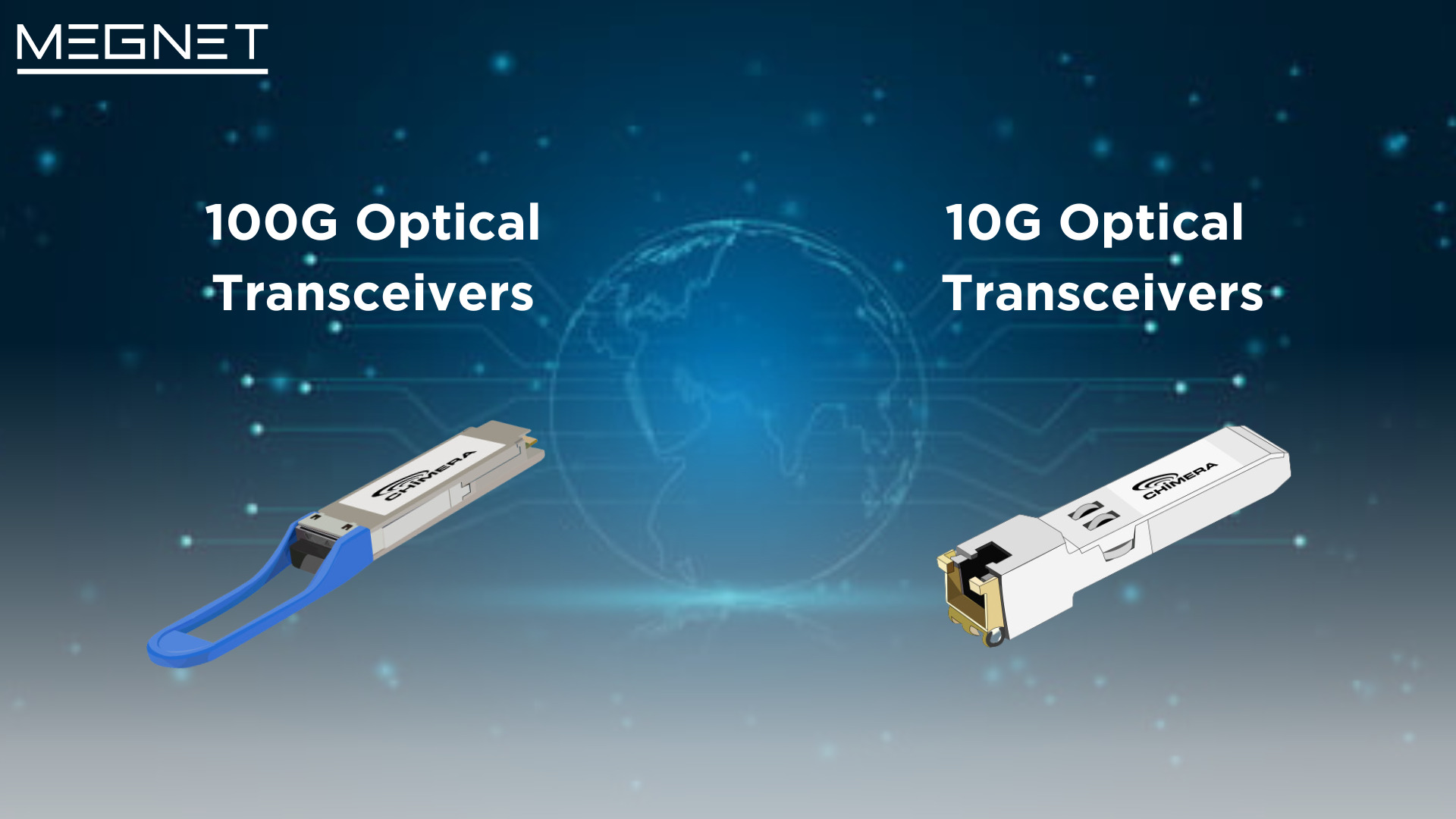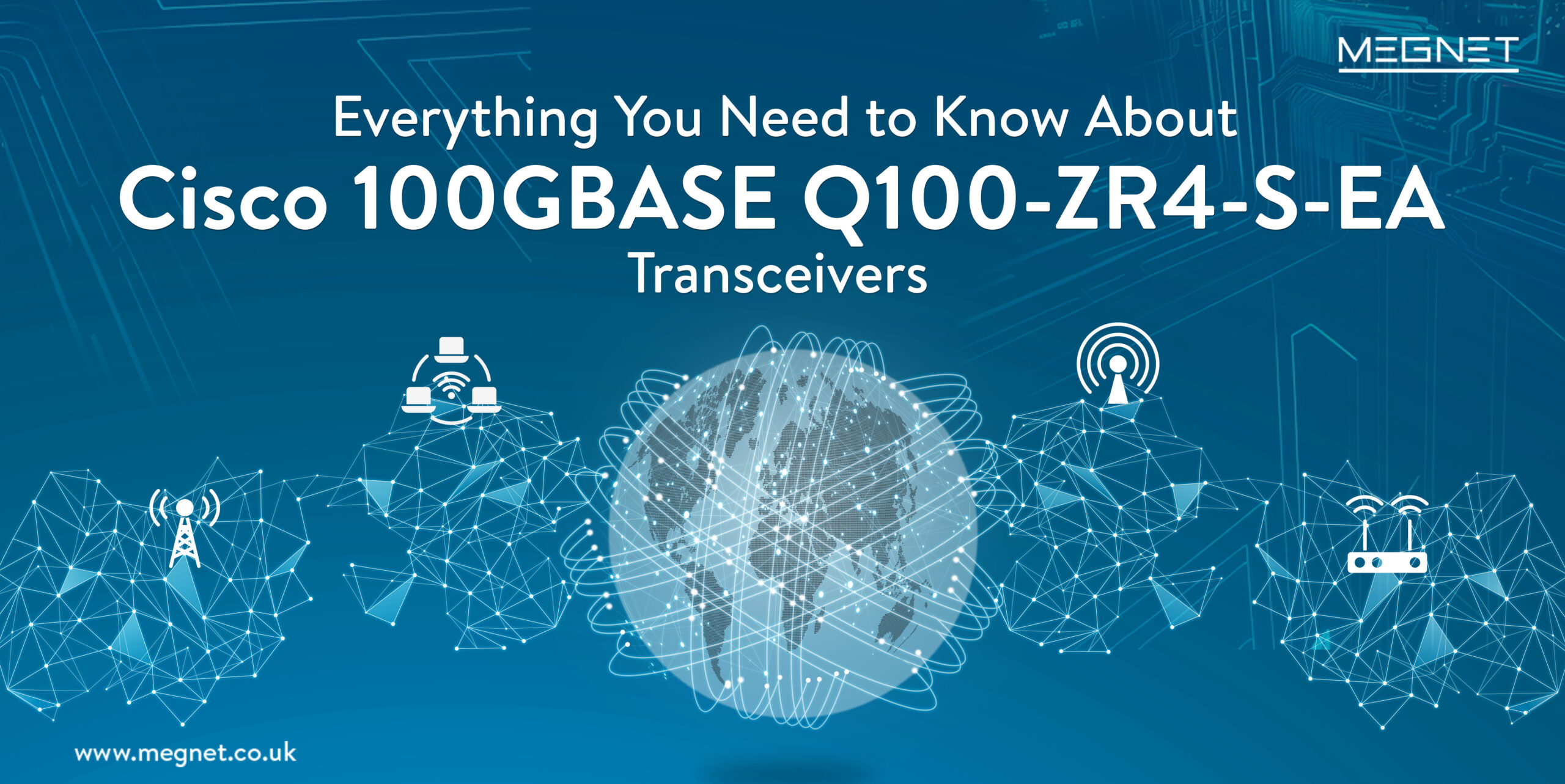Everything You Need to Know About Cisco 100GBASE Q100-ZR4-S-EA Transceivers
With the increasing need for bandwidth from quickly expanding cloud services and data centers, 100G networks are rapidly expanding. 100G optical transceivers are becoming increasingly prevalent as an essential component of the 100G network. In this blog, we’ll help you understand everything you need to know about Cisco 100GBASE Q100-ZR4-S-EA transceivers.
100G Transceivers Type
100G transceivers are typically classified as CFP, CFP2, CFP4, CXP, or QSFP28 according to their form factors.
CFP, CFP2, CFP4, and CXP are early forms of 100G optical transceiver, while QSFP28 is the newest version of 100G optical transceiver, and it has become the standard form of 100G optical transceiver due to its reduced power consumption and higher density.
Like 40G QSFP +, which has four 10Gbps channels, 100G QSFP28 has four 25Gbps channels.

What are Cisco 100GBASE Q100-ZR4-S-EA transceivers?
Cisco 100G transceivers are high-performance optical modules that are used for data transmission. These one-of-a-kind transceivers use wave division multiplexing technology to transmit data without compromising signal quality. They are useful for large data centers and long-distance data transmissions because they provide unparalleled bandwidth and stable links.
The 100G QSFP28 ZR4 is designed for optical communication applications with an 80-kilometer range. A four-lane optical transmitter, a four-lane optical receiver, and a module administration block with a two-wire serial interface are included in this module. The optical signals are multiplexed to a single-mode fiber using an industry-standard LC connection.
Customers can use the Cisco 100GBASE Quad Small Form-Factor Pluggable (QSFP) Q100-ZR4-S-EA to connect to 100 Gigabit Ethernet ZR in data centers, high-performance computing networks, enterprise core and distribution layers, and service provider applications.
To know more about the role QSFP+ type Transceivers, check the linked article.
Features of Cisco 100GBASE Q100-ZR4-S-EA transceivers
- A hot-swappable input/output device that can connect to a 100G Gigabit Ethernet Cisco QSFP port
- Certified and validated for use on Cisco QSFP-100G ports, ensuring greater performance, quality, and dependability
- A high-speed electrical interface that complies with the IEEE 802.3bm standard
Benefits of using Cisco 100GBASE Q100-ZR4-S-EA transceivers
High Performance
Cisco 100GBASE Q100-ZR4-S-EA transceivers offer high-speed connectivity, making them ideal for data-intensive applications.
Long-Range Transmissions
With their wave division multiplexing technology, these transceivers can transmit data up to 80km, making them perfect for long-range data transmissions.
High-Quality Signals
Their signal quality is top-notch, with a low bit error rate, ensuring that there’s no data loss during transmission.
Note:
- With a standard pair of G.652 single-mode fiber and duplex LC connectors, the Cisco Q100-ZR4-S-EA can handle links that are up to 80 km long.
- The signal for 100 Gigabit Ethernet is sent over four different wavelengths.
- The device takes care of the multiplexing and demultiplexing of the four wavelengths. The host platform needs to employ FEC in order for the module to work.
Technical Specifications

Connectors and Cablings

Note: In the above table, for modal bandwidth, it must be noted that the Maximum reach is of 80 km (engineered Link) with 29dB link loss.
Also, Fiber attenuation is of 0.35dB/km (instead of 0.43dB/km worst case) with 1dB connectors loss.
Optical Characteristics

Note: *1 Transmitter and receiver power is average optical power, unless specified.
*2 Optical power at RX is informative only. A received power within this range is required but does not ensure operation.
Dimensions
The QSFP connection module’s maximum exterior dimensions are (H x W x D) 13.5 x 18.4 x 72.5-79 mm; D at the top of the range is 6.5 mm larger than MSA.
Usually weighs less than 100 grams.
Environmental conditions
Operating temperature range:
- The commercial temperature range is 0 to 70°C (32 to 158°F); however, the platform ambient temperature range is limited to 0 to 46°C (32 to 115°F).
- Temperature range for storage: -40 to 85°C (-40 to 185°F).
Warranty
- Warranty terms are typically for five years.
Ordering information
The below table provides the ordering information for the module.

Regulatory and standards compliance
Standards
- SFF-8665: QSFP+ 28 Gb/s 4X Pluggable Transceiver Solution (QSFP28) – Rev 1.8 May 10, 2013
- SFF-8636: Common Management Interface – Rev 2.10
- 802.3™-2012 IEEE Standard for Ethernet
- IEEE 802.3ba Amendment of IEEE Std 802.3-2012
- IEEE 802.3bm Amendment of IEEE Std 802.3-2012 (D3.1, 1st August 2014)
- GR-20-CORE: Generic Requirements for Optical Fiber and Optical Fiber Cable
- GR-326-CORE: Generic Requirements for Single-Mode Optical Connectors and Jumper Assemblies
- GR-468-CORE: Generic Requirements for Optoelectronic Devices Used in Telecommunications Equipment
- GR-1435-CORE: Generic Requirements for Multi Fibre Optical Connectors
- RoHS 6
Safety
- The modules are compliant with Laser Class 1 as defined in IEC 60825-1 and IEC 60825-2 and comply with 21 CFR 1040.10 and 1040.11.

Overall, the Cisco 100GBASE Q100-ZR4-S-EA transceivers provide a reliable and efficient solution for 100G network connectivity, offering high performance, long-range transmission capabilities, and top-notch signal quality.
If you are looking for Cisco 100GBASE Q100-ZR4-S-EA transceivers or Cisco Compatible Transceivers, get in touch with us today!
Check out our range of transceivers.
FAQ's
The Cisco® 100GBASE Quad Small Form-Factor Pluggable (QSFP) portfolio provides a wide range of high-density, low-power 100 Gigabit Ethernet connectivity options for data centers, high-performance computing networks, enterprise core and distribution layers, and service provider applications.
The wavelength of a Cisco BiDi is as follows: The 1G BiDi SFP, also known as the 1000BASE-BX SFP, uses two separate wavelengths (1310nm-TX/1490nm-RX, 1310nm-TX/1550nm-RX, 1490nm-TX/1550nm-RX, and 1510nm-TX/1570 nm-RX) for transmission across varying distances.
The 100G QSFP28 SR4 is a 4-channel, full-duplex, hot-pluggable fiber optic transceiver module for the 100G Gigabit Ethernet operation. It has four distinct transmission and receiving signal channels, each of which operates at a rate of 25.78Gbps.
100G port speed or 100 Gigabit Ethernet standard (also known as 100 GbE) allows for transmission rates of up to 100 Gbps (gigabits per second). It offers transfer rates that are 10 times faster than 10 GbE
The five most prevalent varieties of 100G QSFP28 modules are the QSFP 100G SR4, QSFP 100G LR4, QSFP 100G PSM4, QSFP 100G CWDM4, and QSFP 100G ER4. Each of the type is designed to meet the different transmission distance requirements
There are several 100G interface standards, such as SR4 (Short Reach), SR10, LR4 (Long Reach), ER4, and ZR4. The normal electrical signals for all of these are 1010G, while the external optical signal for LR4 and ER4 is 425G. Also, SR4 and SR10 are mostly used to send information over short distances
There are generally two types of 100G DAC cables: 100G Active DAC and 100G Passive DAC. 100G Passive DAC typically comes in three distinct categories: 100G QSFP28 to 100G QSFP28 Passive DAC, 100G QSFP28 to 4 25G SFP28 Passive DAC, and 100G QSFP28 to 2x 50G QSFP28 Passive DAC
The QSFP-100G-ZR4-S runs on the same LAN WDM grid as other transceivers, having center wavelengths of about 1295, 1300, 1304, and 1309 nm.
QSFP stands for Quad Small Form Factor Pluggable. QSFP is available in single-mode and multimode configurations, with each channel capable of transmitting at up to 1.25 Gbps, for a total speed of more than 4 Gbps
The QSFP module has four channels in each direction with a total bandwidth of 40 Gb/s, with each channel running at up to 10 Gb/s at distances of up to 100 meters (328 feet).










Leave a comment
Your email address will not be published. Required fields are marked *